Survey respondents provide information that identifies their age, gender, length of time as a volunteer with CFA and brigade type. This information is collated and used to provide material for further analysis.
Gender
In 2014, 86% of survey respondents were male, and 14% female. This is an under representation of the total CFA female volunteer membership, as CFA data indicates that 20% of CFA volunteers are female. The promotion of future surveys to encourage an increased female representation closer to the total membership percentage would benefit the results.
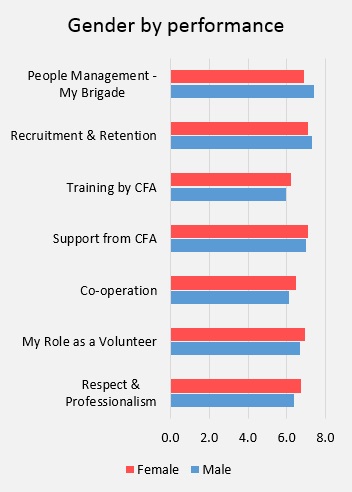

Female survey respondents rated ‘people management – my brigade’ and ‘recruitment and retention’ performance lower than male respondents across the seven themes.
The differences occur when the questions relate to CFA’s performance in conflict resolution, bullying and harassment, in which case, females rate the management of such issues lower than males.
The most telling survey response was in response to the statement “there are no barriers to the roles women can occupy in my brigade”. Females feel that importance and more so performance against this statement are lower than their male counterparts, therefore female respondents see a greater gap.
Nine other survey statements relating to recruitment, retention and brigade behaviour were tested against gender responses; none of the tested statements showed a gender influenced 1.0 gap difference in the above statement. No other statement showed more than 0.5 in gap difference when compared across gender.
More than one third (37%) of survey respondents were in the 40-54 age cohort, which is reflective of the 2010 volunteer participation rate by age as illustrated in the Victorian Auditor General Office 2014 audit Managing Emergency Services Volunteers (p.2).
Survey results broken down by the age range of the volunteer against performance scores show that the overall satisfaction in CFA and brigade is highest in the +65 age group. This may relate to a broader point in life where such views are possibly held on most issues.
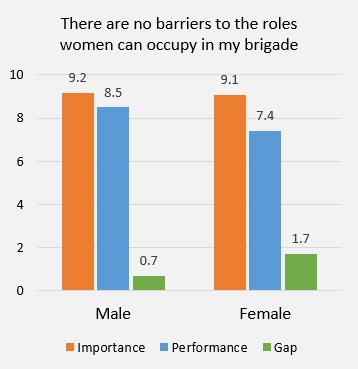
The second highest age range to rank CFA highly is the under 25 year old group, this may relate to length of service and a sense of optimism and future reward within CFA.
Age.
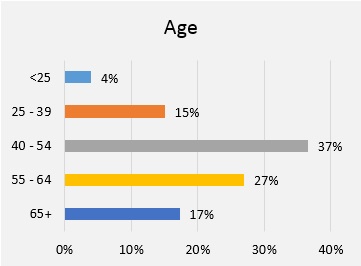
More than one third (37%) of survey respondents were in the 40-54 age cohort, which is reflective of the 2010 volunteer participation rate by age as illustrated in the Victorian Auditor General Office 2014 audit Managing Emergency Services Volunteers
Survey results broken down by the age range of the volunteer against performance scores show that the overall satisfaction in CFA and brigade is highest in the +65 age group. This may relate to a broader point in life where such views are possibly held on most issues.
The second highest age range to rank CFA highly is the under 25 year old group, this may relate to length of service and a sense of optimism and future reward within CFA.
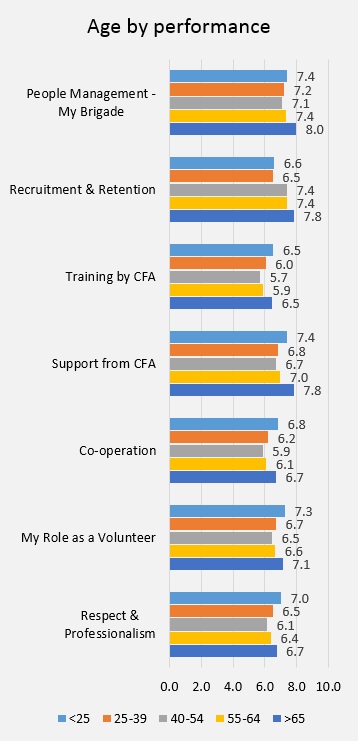
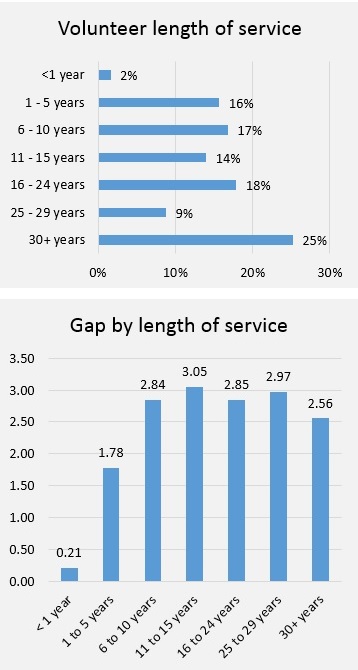
Length of service as a volunteer.
One quarter of survey respondents have spent more than 25 years as a CFA volunteer, the largest length of service group in the survey, whilst 2% had spent less than one year in CFA as a volunteer and 16% less than five years.
Survey results for gap scores were tested against respondents’ age range to see if trends could be identified.
Volunteer length of service created a distinct pattern across the question responses. Volunteers who have served with CFA for less than one year are the most positive about the organisation and their brigade on nearly every question.
Two distinct increases in the gap between importance and performance occur; firstly in respondents with more than one years’ service and then again in volunteers with more than five years’ service. The gap sharply increases after their first year of service, i.e. their level of satisfaction drops sharply after one year and then again after more than five years’ service
Length of service related positivity then begins to reduce the gap back up to the 30+ years’ service mark.
Brigade service/risk environment.
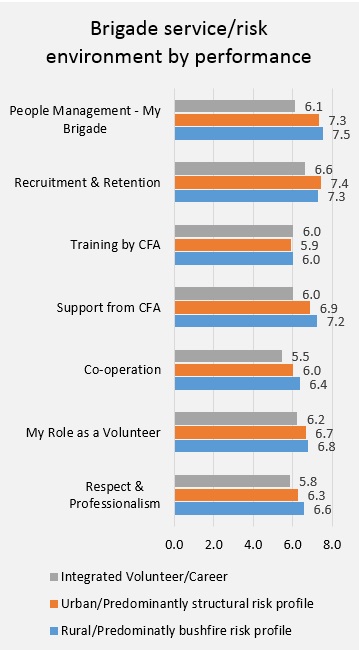
Volunteer membership of four types of brigade service/risk environment could be nominated by the survey respondents, these being;
- Rural/predominantly bushfire risk profile.
- Urban/predominantly structural risk profile.
- Integrated volunteer/career.
- Coast guard brigade.
Only one survey response was received from a coast guard brigade member, therefore this response has little impact on the brigade service environment analysis.
The integrated volunteer/career survey responses consistently scored lower on importance and more so on performance. Integrated brigades scored poorly on performance in relation to workplace bullying, conflict resolution, volunteer consultation, morale and supporting new volunteers. These particular statistical results point to ongoing issues within integrated brigades that require specific attention.
When the nominated brigade service/risk environment responses are tested against performance scores for the survey themes, the results generally show (for five of the seven themes) that brigades with a predominantly rural/bushfire risk rate CFA performance more highly and integrated volunteer/career brigade rate CFA performance the lowest. The only two variations in this trend are where all three brigade service/risk environments rate training performance very closely (6.0, 5.9 and 6.0) and where urban/predominantly structural risk brigades rate recruitment and retention performance higher.
The most marked variation in performance scores between brigade service/risk environments is in the ‘people management – my brigade’ theme where volunteers in integrated volunteer/career brigades rated performance 1.2 below urban/structural risk and 1.4 below rural/bushfire risk types.
The survey performance scores by brigade service/risk environment are reflected in some of the written survey comments, where volunteers feel that the treatment they receive and the relationship they have with career staff are not as good as they should be.
The survey results suggest that further work in understanding the specific issues facing integrated volunteer/career brigades is required in order to improve working relationships between CFA volunteers and CFA career staff.
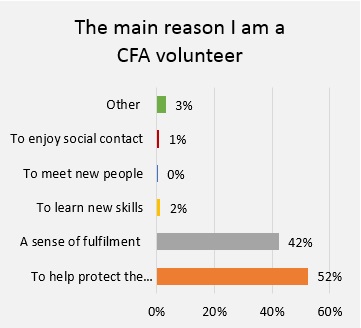
Reason for being a volunteer.
Survey respondents are asked to select their main reason for being a CFA volunteer from six listed options.
Slightly more than half the survey respondents (52%) nominated “to help protect the community I live in” as their main reason, whilst a considerable proportion (42%) nominated “a sense of fulfilment in supporting my community in a meaningful way” as their main reason.
These results are highly aligned to the 2013 survey results, where 50% of respondents nominated “to help protect the community I live in” as their main reason and 44% nominated “a sense of fulfilment in supporting my community in a meaningful way”.
The other four options for both the 2013 and 2014 survey results rated very low by comparison, (4% combined in 2013 and 6% combined in 2014).
When compared to satisfaction levels against the statement “I would recommend being a CFA volunteer to people I know” these results suggest that volunteers play an important part in recruitment, as they are highly motivated by their volunteer experience and keen to see others enjoy the same experience.
Awareness of VFBV.
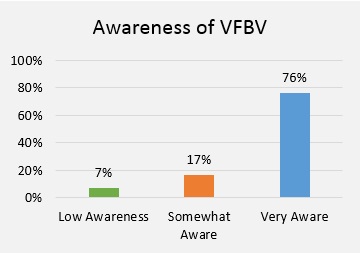
The number of respondents with reasonably high awareness of VFBV had grown from 71% to 76% compared to last year. There are still many volunteers with either low or only moderate awareness of VFBV, so this is an area for continued attention.
The comments received suggest that many volunteers feel a low awareness of VFBV or being aware of the VFBV overall but not feeling a good enough understanding of what VFBV does. Also, how processes work or how they easily access information on particular issues.
Consistent with previous years there is a diverse spectrum of comments regarding whether VFBV should be more forthright in representing volunteers through to some thinking VFBV is too assertive. Comments describing a tension between pursuing a fair go for volunteers and maintaining harmony, particularly regarding issues where CFA workforce culture, arrangements and industrial agreements impact on areas that also directly affect volunteers.
There are also a mix of comments regarding how VFBV should work as a close partner with CFA and Government versus VFBV needing to be more independent and more publically critical of policy and direction that is not good for volunteers.
Comments reinforce the desire of volunteers to have a grass roots connected, well organised, well-resourced volunteer voice but at the same time a strong concern that the funding of such a voice must not erode VFBV’s independence and objectivity.
There are many comments recognising improvements in VFBV engagement and visibility amongst volunteers and also many comments asking VFBV to communicate achievements more broadly and increase the profile of VFBV at brigade level.
A number of comments express a frustration that VFBV is not vocal enough in the public and media debate complaining of the absence of a strong CFA leadership voice. VFBV needs to do more to educate the community about the importance of CFA volunteers and to defend the reputation of volunteers, when it is put down by interest groups with particular agendas.
